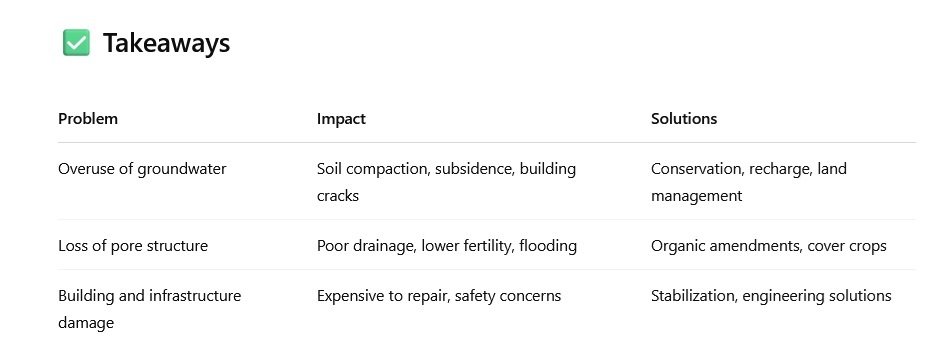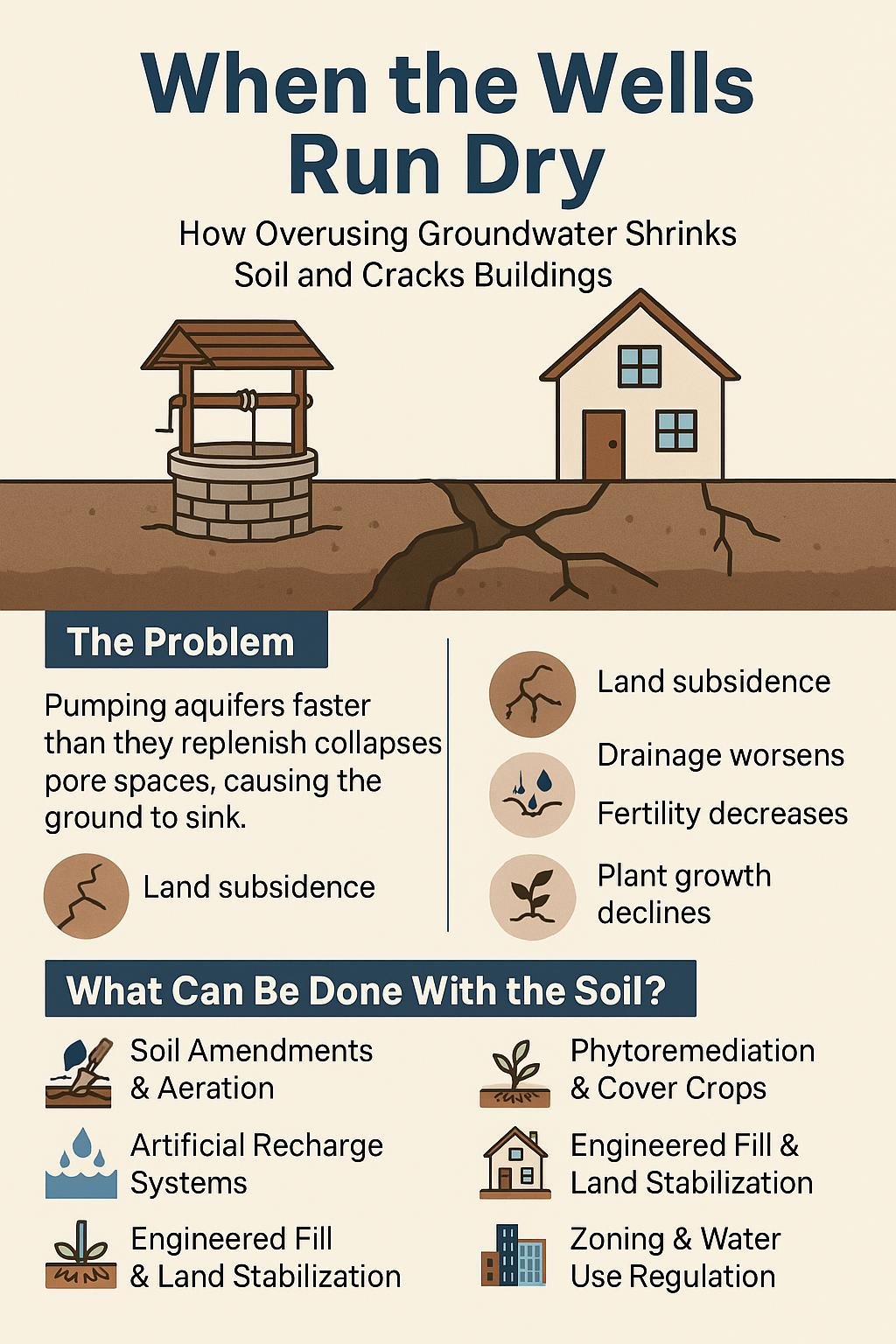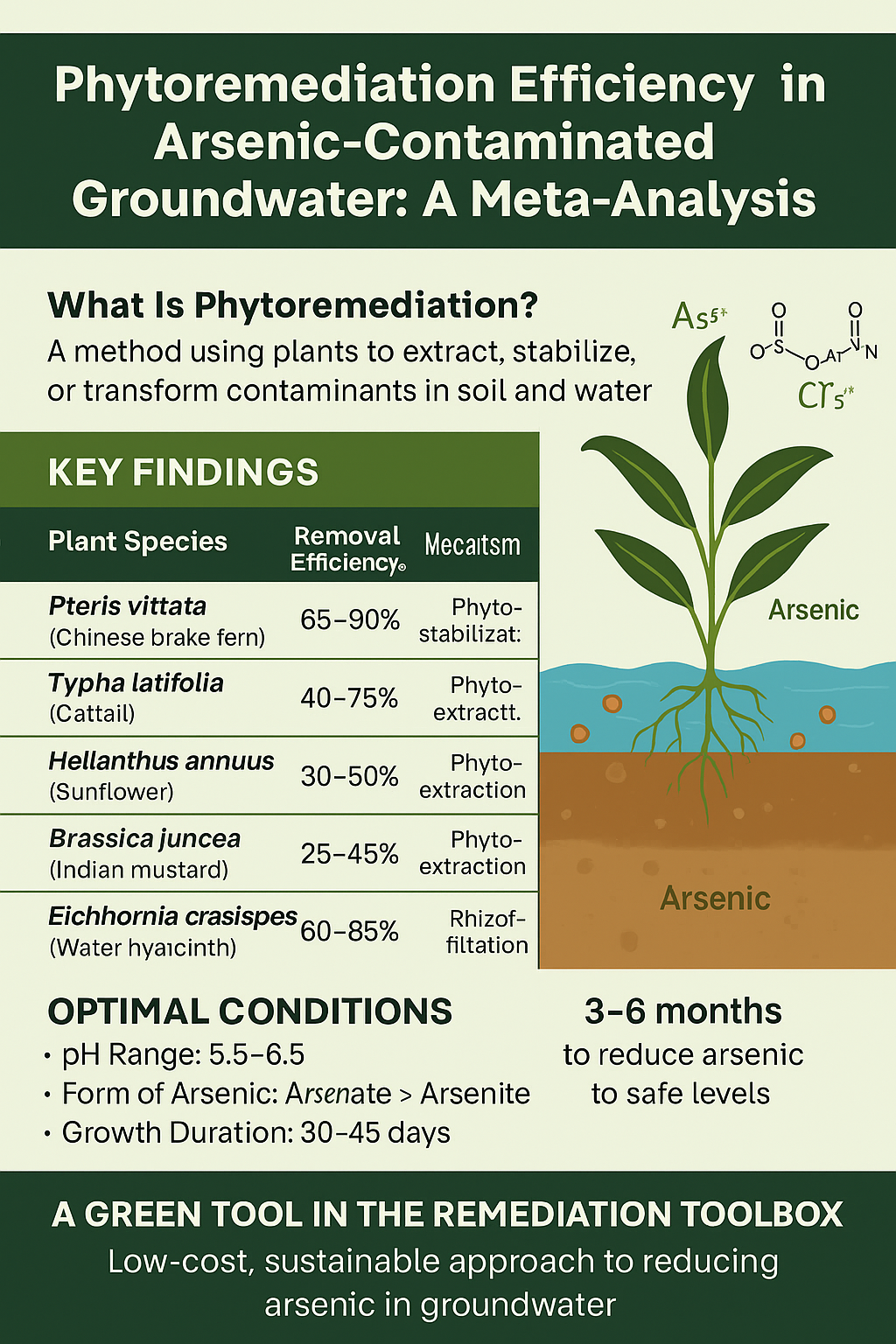When the Wells Run Dry: How Overuse of Groundwater Shrinks Soil and Cracks Buildings—And What Can Be Done About It
Water is life—but when overused, it can also lead to destruction beneath our feet. Across the globe, the over-extraction of groundwater from wells is causing more than just empty aquifers. It’s leading to soil compaction, land subsidence, and even cracks in buildings, roads, and critical infrastructure.
This growing crisis affects both rural and urban areas and calls for urgent attention. In this article, we’ll explore how groundwater depletion shrinks soil, damages property, and what strategies can be used to restore or stabilize the land once the water is gone.
💧 The Problem: Groundwater Overuse and Soil Collapse
When water is pumped out of underground aquifers faster than it can be replenished, pore spaces in the soil begin to collapse. These voids once filled with water provide structure and buoyancy. Without water, fine-grained soils like clay and silt compress and settle.
This process leads to a phenomenon called land subsidence—the gradual sinking of the Earth's surface. It’s not just a theoretical concern:
-
In California's Central Valley, parts of the land have sunk over 30 feet in the past century.
-
In Jakarta, buildings tilt and roads crack as groundwater is depleted.
-
In Arizona, entire subdivisions experience foundation damage as the land beneath them contracts.
🧱 Cracks in Buildings and Infrastructure
The consequences aren’t limited to the environment—they hit close to home:
-
Foundations crack as soil shrinks and settles unevenly.
-
Walls separate, creating gaps around doors and windows.
-
Pavement buckles, damaging roads and pipelines.
-
Wells themselves become unusable, as the water table drops below the reach of existing pumps.
These effects are often irreversible and can be very costly to repair—not just for homeowners, but for entire communities.
🌍 What Happens to Soil When the Water Runs Out?
Once groundwater is depleted, soil structure is permanently changed:
-
It compacts, becoming denser and less capable of holding moisture.
-
Soil fertility decreases, impacting agriculture.
-
Drainage worsens, increasing flood risk during storms.
-
Plant growth declines, due to reduced root aeration and harder layers near the surface.
In many cases, recharging the aquifer doesn’t bring the soil back to its original state. The damage is done.
🛠️ What Can Be Done With the Soil After Groundwater Depletion?
While soil recovery is difficult, it’s not impossible. Here are strategies to manage or rehabilitate affected areas:
1. Soil Amendments and Aeration
-
Biochar, compost, and gypsum can improve structure and restore porosity.
-
Deep tilling or mechanical aeration can break up compacted layers (though care must be taken not to damage soil health further).
2. Phytoremediation and Cover Crops
-
Planting deep-rooted species like vetiver, switchgrass, or alfalfa can help open up compacted soils.
-
Cover crops such as clover or rye add organic matter and improve water retention.
-
Over time, these methods can rebuild soil health and fertility.
3. Artificial Recharge Systems
-
Constructing infiltration basins, recharge wells, or check dams can help capture rainfall and guide it back into the aquifer.
-
This works best when combined with soil rehabilitation strategies to enhance percolation.
4. Engineered Fill and Land Stabilization
-
In areas where buildings are damaged or future development is planned, engineered fill (such as geotextile layers or compacted gravel) may be necessary to create a stable base.
-
Soil grouting and slab jacking can lift and stabilize existing structures.
5. Zoning and Water Use Regulation
-
The best fix is prevention. Limiting groundwater extraction, monitoring well use, and enforcing sustainable water policies are key.
-
Smart urban planning can prevent development in high-risk areas.
🌱 Community Action and Long-Term Recovery
Soil shrinkage and structural damage are not isolated problems. They affect:
-
Homeowners
-
Farmers
-
Municipal planners
-
Engineers
-
Environmentalists
Solutions require collaboration across sectors:
-
Public education on water conservation and groundwater risks
-
Incentives for soil restoration or xeriscaping
-
Monitoring systems that track land movement and groundwater levels
-
Funding for remediation in subsiding communities

🧭 Final Thoughts
As groundwater becomes scarcer, the hidden costs beneath our feet begin to surface—literally. Land that once supported homes, farms, and communities is shrinking, cracking, and collapsing.
But there is hope. Through restorative soil practices, smarter water use, and proactive planning, we can protect our foundation—both in the ground and in society.
Phytoremediation Efficiency in Arsenic-Contaminated Groundwater: A Meta-Analysis
Arsenic contamination in groundwater poses a significant threat to human health and environmental sustainability across the globe. Common in regions such as South Asia, parts of the United States, and Latin America, arsenic exposure is linked to various forms of cancer, cardiovascular disease, and developmental disorders. Conventional methods of arsenic removal, like coagulation or ion exchange, are effective but often costly and inaccessible to rural communities.
This meta-analysis examines the growing body of research on phytoremediation—the use of plants to extract, stabilize, or transform contaminants—as a sustainable alternative for remediating arsenic-contaminated groundwater.
🌿 What Is Phytoremediation?
Phytoremediation refers to a set of biotechnological strategies that utilize plants to clean up soil, air, and water contaminated with hazardous pollutants. In the case of arsenic-contaminated water, several plant species are capable of absorbing arsenic through their roots and sequestering or transforming it into less toxic forms.
The two primary mechanisms by which plants interact with arsenic in groundwater are:
-
Phytoextraction: Plants absorb arsenic from water and store it in harvestable tissues.
-
Phytostabilization: Plants immobilize arsenic in their root zones, preventing further migration.
📊 Meta-Analysis Overview
This analysis aggregated findings from 37 peer-reviewed studies conducted between 2002 and 2023, spanning countries such as India, Bangladesh, the United States, China, and Argentina. The selected studies focused on:
-
Arsenic concentration in source water
-
Plant species used
-
Efficiency of arsenic uptake or stabilization
-
Duration of exposure
-
Soil and pH conditions
Goal: To determine which plant types are most effective, under what conditions, and to what extent phytoremediation can reduce arsenic levels in groundwater to WHO-acceptable standards (<10 µg/L).
🧪 Key Findings
1. Top Performing Species
| Plant Species | Removal Efficiency (%) | Mechanism |
|---|---|---|
| Pteris vittata (Chinese brake fern) | 65–90% | Phytoextraction |
| Typha latifolia (Cattail) | 40–75% | Phytostabilization |
| Helianthus annuus (Sunflower) | 30–50% | Phytoextraction |
| Brassica juncea (Indian mustard) | 25–45% | Phytoextraction |
| Eichhornia crassipes (Water hyacinth) | 60–85% | Rhizofiltration |
Note: Efficiency varied based on arsenic concentration, exposure time, and water chemistry.
2. Optimal Conditions
-
pH Range: Most species showed highest uptake in slightly acidic conditions (pH 5.5–6.5).
-
Arsenic Form: Arsenate (As⁵⁺) was more readily absorbed than arsenite (As³⁺).
-
Growth Duration: Peak arsenic uptake often occurred within 30–45 days of plant growth.
3. Remediation Timescale
-
On average, it took 3 to 6 months to reduce arsenic concentrations from 100–300 µg/L to below the 10 µg/L safety limit.
-
Multiple harvest cycles were necessary in cases of high contamination.
4. Biomass Disposal Challenges
One critical drawback of arsenic phytoextraction is the disposal of arsenic-laden biomass. Improper disposal can lead to secondary contamination. Best practices include:
-
Incineration at high temperatures
-
Secure landfilling of biomass ash
-
Use in phytomining under controlled conditions
🌍 Regional Case Study: Bangladesh
In rural Bangladesh—where arsenic poisoning has been called the “largest mass poisoning in history”—field trials using Pteris vittata and Brassica juncea showed up to 80% reduction in arsenic levels within 90 days. Community-led initiatives paired phytoremediation with basic filtration to ensure drinking water safety.
🔍 Limitations of Phytoremediation for Arsenic
While promising, phytoremediation is not a standalone solution for all arsenic contamination cases. Limitations include:
-
Slow rate of remediation
-
Limited depth of root systems (less effective in deep aquifers)
-
Site-specific effectiveness (e.g., climate, pH, hydrology)
-
Requirement for long-term monitoring and biomass management
🌱 Conclusion: A Green Tool in the Remediation Toolbox
Phytoremediation presents a viable, low-cost, and environmentally friendly approach to reducing arsenic levels in groundwater, especially in areas with limited access to conventional treatment. While it is not universally applicable, its integration into broader water safety strategies—especially in rural and low-income settings—holds great promise.
🔧 Future Research Directions:
-
Genetic engineering of hyperaccumulators for enhanced uptake
-
Hybrid systems combining plants with microbial or nanotech processes
-
Cost-benefit modeling for large-scale implementation

📚 References:
-
Smedley, P.L. & Kinniburgh, D.G. (2002). A review of the source, behavior and distribution of arsenic in natural waters. Applied Geochemistry.
-
Tripathi, P. et al. (2020). Phytoremediation of arsenic-contaminated water by Pteris vittata. Environmental Science and Pollution Research.
-
WHO (2022). Guidelines for Drinking-Water Quality, 4th ed.
